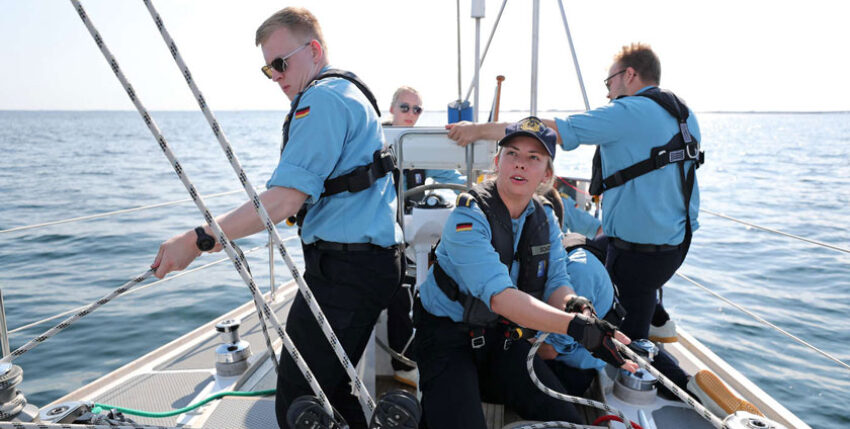[et_pb_section fb_built="1" _builder_version="3.22" global_colors_info="{}"][et_pb_row _builder_version="3.25" background_size="initial" background_position="top_left" background_repeat="repeat" global_colors_info="{}"][et_pb_column type="4_4" _builder_version="3.25" custom_padding="|||" global_colors_info="{}" custom_padding__hover="|||"][et_pb_text _builder_version="4.14.1" background_size="initial" background_position="top_left" background_repeat="repeat" custom_margin="-50px||||false|false" global_colors_info="{}"]
From a press release by the Navy
The fact that prospective naval officers learn to sail is not a relic of days gone by, but a necessary part of their training: seamanship must be acquired, and leadership can be learnt. The first crew has now completed the new military sailing training programme. A look at the experiences of the sea cadets and their instructors.
The service sailboats
Learning to sail is a tradition at the Mürwik Naval Academy - and not just on the training sailing ship "Gorch Fock". The fleet of service sailboats comprises a total of 25 training yachts. Seven new eleven-metre Sunbeam 36.2 yachts were only added in 2020. However, the existing Hanseat 70 and Nadine 24 training yachts, which are around 40 years old, will remain in service. This is about the team of individuals.
The sail training ship and the navy
The new service sailboats are not intended to replace the training on the "Gorch Fock", nor the practical training on the grey units, i.e. the navy's frigates, corvettes and minehunters. "The 'Gorch Fock' teaches teamwork and camaraderie in a larger crew. On the grey boats and ships, the officer candidates experience everyday life in military units," explain the sailing instructors Sommerfeld and Hillenberg.
The trainers
Staff Captain Lieutenant Marten Sommerfeld adds: "Military sailing is not just recreational fun in uniform. Wind and weather, waves and currents harbour dangers that a naval officer must be able to assess. The best way to learn this is to get up close and personal. You're not up close on a frigate. But you are when sailing." Chief Boatswain Magnus Hillenberg also emphasises: "You learn sensitivity best on a small boat, where you can feel every wave and every gust."
The concept of military sailing training
As before, one focus of the training is on the basic concepts of sailing: setting sails, tacking and gybing, steering, mooring and casting off and, in the final step, cruising with stage and route planning. The second focus has been added in the revision: military matters. The first processes and standards of the navy should be learnt right from the start: Sea clearance survey, manoeuvre whistle blowing and blowing off, lining up at the manoeuvre station when entering and leaving, flag dipping, towing and being towed.
The first step into seafaring
Officer cadets from traditional naval or seafaring families have become rare, and very few of them have any connection to seafaring or even water sports. The majority of sea cadets must therefore first be familiarised with the sea. Two weeks on a sailing yacht in all weathers trains not only nautical and seamanship skills, but also camaraderie and leadership skills. Living together in a confined space requires tolerance and consideration. At the same time, the character traits of the sea cadets come to the fore in stressful situations. And what is training other than mastering routines, experiencing limits, experiencing aha moments and living through moments of fear?
That's the way it is!
Flotilla Admiral Wilhelm Tobias Abry, until recently commander of the Mürwik Naval Academy, summarises in two sentences:
Even when it is cold, wet and dark, the sea cadets have to bring their boat safely into harbour: with discipline, perseverance and a willingness to take responsibility as a team - qualities that they will need later on in order to credibly lead the men and women entrusted to them as officers.
On a sailing boat, a young sea cadet realises for the first time that his orders have immediate consequences - for the comrades he leads, for the boat he is responsible for and for the mission he has to fulfil.
Click here for the message https://www.bundeswehr.de/de/aktuelles/meldungen/neue-militaerische-segelausbildung-5261744
[/et_pb_text][et_pb_gallery gallery_ids="15609,15610,15611,15612,15614,15615,15602" fullwidth="on" _builder_version="4.14.1" _module_preset="default" global_colors_info="{}"][/et_pb_gallery][et_pb_video src="https://youtu.be/5JgPY5PQoMI" _builder_version="4.14.1" _module_preset="default" global_colors_info="{}"][/et_pb_video][/et_pb_column][/et_pb_row][/et_pb_section]










